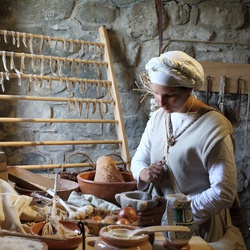Diet in the Middle Ages. At table, in the fourteenth and fifteenth centuries
Valle del Serchio. Più vicino a te

The diet of the period can be deduced from information in the widest range of documents, such as extracts from letters, notes, inventories and literary works of the fourteenth and fifteen centuries. Although we know more about the cuisine of the nobility than that of the common people, we can state with a certain confidence that the medieval cuisine featured a great variety of foodstuffs and strict respect for their seasonal nature.
Bread, a very different food from that known today, was the main source of sustenance for the poorest classes, who were almost exclusively given black bread (with a low percentage of wheat), so that its colour became an indication of social differentiation. It was baked on “testelli” (flat terracotta trays), which gave it an appearance similar to focaccia.
Basic foodstuffs were cereals such as rye, a variety of emmer called “spelta”, barley, buckwheat, oats, emmer, millet and sorghum with which they prepared soups, polenta and flour. In periods of famine and in the mountain areas, the cereals were replaced with more humble and more easily found foodstuffs, such as chestnuts, acorns and dried vegetables (chickpeas, beans, grass peas and peas).
Fruit was very common and was used to prepare many recipes. Apples, pears, plums and berries were consumed at the end of meals in the form of compotes and to accompany meats, and, together with honey, they played a major role in sweetening foodstuffs.
Among the meats, pork was the favourite and obtained from animals slaughtered as adults, very similar to wild boars, with the skin cover in brown-red bristles and strong canine teeth. The rearing of poultry and farmyard birds was also common, while in the mountainous and hilly areas, the meat of game was an enriching contribution to the table of medieval men with pheasants, hares, wild boar and deer.
Water was drunk but wine was also common, much thicker and bitter than modern wines, the reason it was generally diluted with water and mixed with honey. Between meals, this drink was often replaced with the more “modest” vinegar, also used to purify water.
The frequent and long periods of famine that marked the Middle Ages forced people to suffer hunger, and so perfect methods to preserve foodstuffs. The most common was salting (or salification), which preserved food even for long periods. This was one of the reasons salt was one of the absolutely vital goods, used as an object of exchange and regulated by specific legislation. Thanks to the routes that connected the mountains of the Valle del Serchio to the Tuscan and Ligurian coasts, salt was widespread throughout the territory and was a fundamental economic resource.
The diet of the moneyed classes, be they an ancient noble family or a rich merchant, and those in the castle, was generally richer in animal protein, mostly from hunting, and the cuts of meat reserved for them were usually the best. Spices and aromatic herbs played a fundamental role because they allowed any unappetising tastes to be masked and, at the same time, being rather expensive, they also demonstrated the economic power of the hosts.
The common people ate mostly vegetables and pulses, usually cooked as soup; when any piece of meat "appeared" on the dinner table of people of humbler birth, it usually originated from the less valuable cuts of the animal like the head, offal, tail or paws.
This poor diet was also usually the lot of the troops of the garrison but, when the armies were on the march, procuring the nutritional raw materials was especially difficult: unless armies sacked the countryside or were provided with supply chains, it was necessary to feed armies with non-perishable foodstuffs, such as rye bread, often stale or cooked several times to further dehydrate it, soaked or softened with water or, in the best of cases, used in barley or emmer soups.



